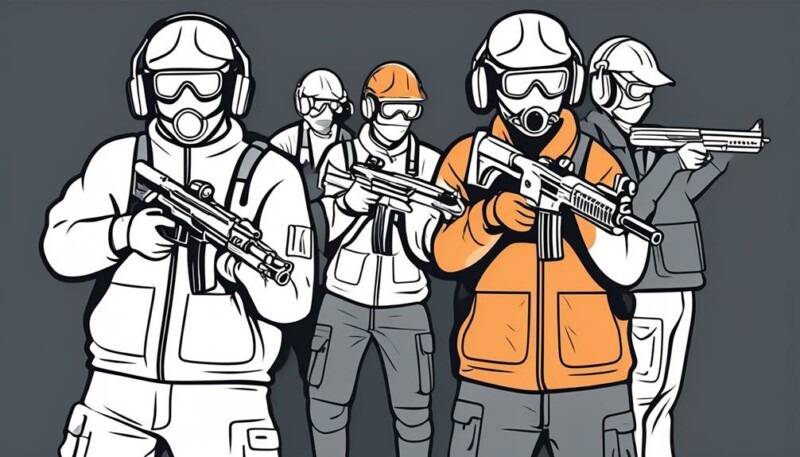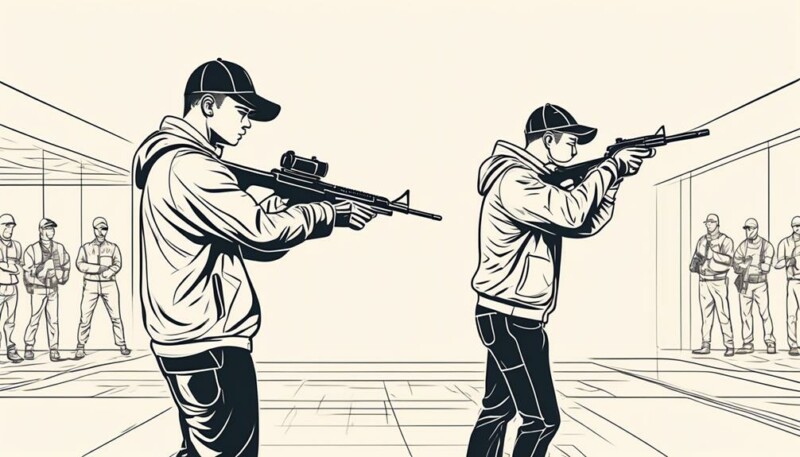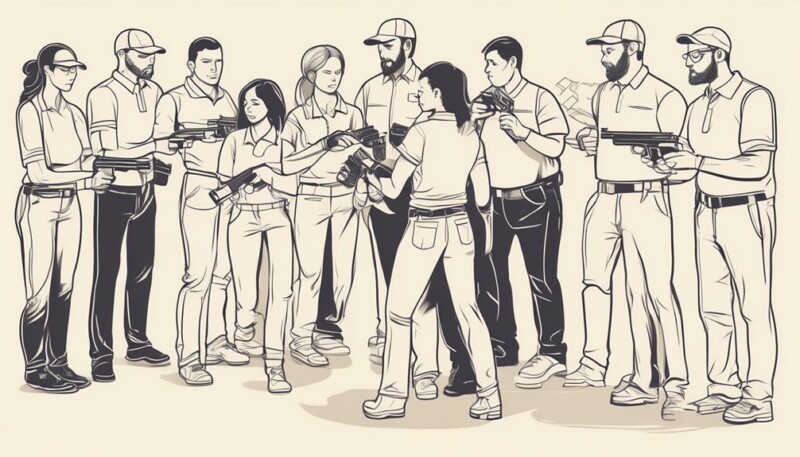You walk into the classroom, feeling a mix of excitement and apprehension. You've decided to take an in-person firearm safety class to learn the essential tips that will ensure your responsible and safe handling of firearms.
As you settle into your seat, you can't help but wonder what valuable knowledge awaits you in this class. Well, wonder no more, because in this discussion, we will explore the essential tips that will equip you with the skills and knowledge needed to handle firearms safely and responsibly.
So, get ready to embark on a journey of firearm safety that will empower you to protect yourself and others.
Key Takeaways
- Choose a training provider that offers comprehensive courses covering gun safety rules and tips, with a focus on safe handling and storage.
- Familiarize yourself with federal, state, and local firearm laws and regulations to ensure compliance with ownership, transport, and usage requirements.
- Prioritize the use of proper safety gear, such as eye and ear protection, to safeguard against potential hazards and promote responsible firearm handling.
- Engage in hands-on instruction and practical exercises to reinforce standard safety knowledge, emphasizing safe muzzle control, unloaded guns when not in use, and proper gun storage, especially in households with children.
Class Requirements and Eligibility
To ensure the safety and effectiveness of our firearm safety classes, it's imperative that you meet the necessary requirements and eligibility criteria. The goal of these classes is to equip individuals with the knowledge and skills needed for responsible gun ownership and safe handling of firearms. As such, certain prerequisites must be met to ensure that participants are adequately prepared for the training.
Firstly, it's essential that you have a basic understanding of gun safety. Familiarity with safety rules and regulations will serve as a foundation for the course material. If you're new to firearms, we recommend taking a beginner's course or reviewing online resources before enrolling in our safety courses.
Additionally, participants must be of legal age to handle firearms and possess the necessary documentation to prove their eligibility. This includes a valid identification card and, in some cases, proof of residency. For those interested in concealed carry, the relevant permits and licenses may be required as well.
Choosing the Right Training Provider

When choosing the right training provider for firearm safety classes, it's crucial to thoroughly research and select a reputable instructor or organization with extensive experience in firearm training.
Here are some factors to consider when making your decision:
- Look for training providers that offer comprehensive courses covering a wide range of gun safety rules and tips. It's important to receive thorough instruction on safe handling, proper storage, and responsible firearm ownership.
- Consider enrolling in firearm training classes that prioritize imparting crucial firearm safety knowledge. A good training provider will focus on teaching you the fundamentals of safe firearm handling, including how to properly load and unload a firearm and how to safely store it.
- Choose training providers that continuously refresh your knowledge and skills through regular training. Firearm safety isn't a one-time lesson, but an ongoing commitment. Look for providers that offer refresher courses or advanced classes to help you stay up to date with the latest safety protocols.
Understanding Firearm Laws and Regulations
Familiarizing yourself with federal, state, and local firearm laws is essential for responsible gun ownership. Understanding and adhering to these laws ensures that you're well-informed about the legal requirements and responsibilities associated with owning firearms.
It's crucial to stay informed about regulations regarding firearm ownership, transport, and usage, as they may vary from one jurisdiction to another.
When it comes to gun safety, knowledge of the law is just as important as safe handling and muzzle direction. Understanding firearm laws and regulations helps you make informed decisions about the proper storage, transfer, and use of firearms, thereby reducing the risk of accidents or illegal activities.
If you have any questions or uncertainties about specific firearm laws, it's advisable to seek legal guidance. Laws can change over time, and it's your responsibility to stay up to date with any amendments or new regulations that may affect your access to firearms.
Complying with background checks, permits, and licensing requirements is crucial when obtaining firearms. By following these procedures, you demonstrate your commitment to responsible firearm ownership and contribute to the overall safety of your community.
Importance of Proper Safety Gear

Understanding and adhering to firearm laws is crucial for responsible gun ownership, and one aspect that shouldn't be overlooked is the importance of proper safety gear. When it comes to handling guns, safety should always be the top priority.
Here are three reasons why proper safety gear is essential:
- Safeguard against potential hazards: Firearms can produce loud noises and eject hot gases and debris. Wearing eye and ear protection, such as protective glasses and ear muffs, helps shield your eyes and ears from these potential dangers. It ensures that you can focus on the task at hand without the fear of injury.
- Prevent injuries: Accidents can happen even to the most experienced individuals. Wearing appropriate safety gear minimizes the risk of injuries caused by flying shell casings, ricochets, or debris. By protecting your eyes and ears, you reduce the chances of permanent damage to your vision and hearing.
- Promote responsible firearm handling: Incorporating safety gear into your routine demonstrates your commitment to safe and responsible gun handling. It reinforces good safety habits and sets an example for others. By wearing safety gear, you show that you prioritize safety not only for yourself but also for those around you.
Hands-On Instruction and Practical Exercises
Engage in hands-on instruction and practical exercises to enhance your firearm competency and develop the necessary skills for safe and responsible gun handling. These activities are crucial in reinforcing safe gun handling practices and instilling the fundamental rules of firearm safety.
During hands-on instruction, experienced gun safety instructors emphasize the importance of safe muzzle control. You'll learn never to aim firearms at anyone and always be aware of the muzzle's direction. Practical exercises further emphasize safe gun handling by teaching you to keep guns unloaded when not in use. This mitigates the risk of accidental discharge and ensures compliance with firearm range rules.
Proper gun storage is another essential aspect covered in hands-on instruction. Instructors stress the importance of securing firearms, especially in households with children. They'll guide you on using secure safes to prevent unauthorized access, helping you safeguard not only yourself but also your family members.
Standard safety knowledge is reinforced through hands-on instruction. You'll learn to keep your fingers off triggers, identify targets accurately, and wear appropriate eye and ear protection. By actively participating in these practical exercises, you'll gain the necessary knowledge to make informed decisions and confidently handle firearms safely.
Enrolling in hands-on firearm safety classes offers a unique opportunity to enhance your firearm competency. Through practical exercises, you'll develop the skills needed for safe and responsible gun handling. Remember, practicing safe gun handling is a lifelong commitment that requires continuous learning and reinforcement.
Developing Safe Handling and Shooting Skills

To develop safe handling and shooting skills, it's essential to focus on three key areas: grip and stance techniques, sight alignment and picture, and trigger control and follow-through.
Proper grip and stance techniques ensure stability and control, allowing you to effectively manage recoil and maintain accuracy.
Sight alignment and picture help you aim accurately and consistently, ensuring that your shots hit the intended target.
Trigger control and follow-through ensure smooth and controlled trigger pulls for improved shot placement.
Grip and Stance Techniques
Developing safe and effective firearm handling skills begins with mastering the proper grip and stance techniques. To ensure safe handling, it's essential to understand the importance of grip and stance in maintaining control and accuracy while shooting. Here are three key points to consider:
- Grip: Maintain a firm grip on the firearm, ensuring that your hand is positioned high on the backstrap. This will allow for better control and minimize the risk of the firearm slipping from your hand during shooting.
- Stance: Adopt a stable and balanced stance, with your feet shoulder-width apart. Distribute your weight evenly between your feet and slightly bend your knees. This will provide a solid foundation and enhance stability and control while shooting.
- Safe direction: Always keep the muzzle pointed in a safe direction, away from yourself and others. This ensures that in case of an accidental discharge, no harm will be caused.
Always handle firearms responsibly and prioritize safety at all times.
Sight Alignment and Picture
To develop safe handling and shooting skills, it's crucial to master the technique of sight alignment and picture. This technique involves aligning the front and rear sights of the firearm with the target to ensure accuracy. Proper sight alignment ensures that the shot will hit the intended target.
When aiming, keep your eye focused on the front sight while maintaining equal height and equal light on both sides of the front sight. Additionally, be mindful of keeping your finger off the trigger until you're ready to shoot. Neglecting this rule can have fatal consequences.
Trigger Control and Follow-through
Proper trigger control and follow-through are essential for developing safe handling and shooting skills. Knowing how to handle a gun is important, but knowing how to manipulate the trigger is equally crucial. Here are some key points to keep in mind:
- Maintain consistent trigger discipline: Always keep your finger off the trigger until you're ready to shoot. This helps prevent accidental firing and ensures that you have full control over the gun.
- Focus on follow-through: After pulling the trigger, maintain your grip and stance, and keep your sights on target. This helps improve accuracy and ensures that you're fully aware of your surroundings.
- Develop muscle memory: Practice controlled trigger manipulation repeatedly to develop muscle memory. This allows you to execute proper trigger control instinctively, even in high-pressure situations.
Continuing Education and Refresher Courses

Continuing your education and taking refresher courses is essential for maintaining your knowledge and skills in firearm safety. As responsible gun owners, it's crucial to stay informed and up-to-date on the safe handling and usage of firearms. There are certain basic rules that every gun owner needs to know, and continuing education can reinforce these principles and help prevent accidents or mishaps.
One of the primary reasons why continuing education is important is because firearm safety isn't a one-time learning experience. Taking refresher courses allows you to review and reinforce the fundamental rules of safe firearm handling. These courses often cover topics such as proper storage, transportation, and maintenance of firearms, as well as the correct way to handle and use different types of firearms.
Additionally, continuing education provides an opportunity for gun owners to learn about any new laws or regulations that may have been implemented since they last received training. Laws pertaining to firearms can change over time, and it's essential to stay informed to ensure compliance and safe practices.
Refresher courses also give you the chance to practice and refine your skills. Regular training sessions can help maintain muscle memory and improve your proficiency in handling firearms. By honing your skills through continuing education, you can become more confident and capable in any situation that may arise.
Frequently Asked Questions
What Are the 4 Golden Rules of Gun Safety?
The 4 golden rules of gun safety are crucial for anyone interested in personal defense.
- It's important to handle firearms safely by always keeping the muzzle pointed in a safe direction and treating every gun as if it's loaded.
- Additionally, keeping your finger off the trigger until ready to shoot is essential to prevent accidental discharges.
- Being aware of your target and what's beyond it is another key component of comprehensive firearm safety.
What Are the 4 Primary Rules of Firearm Safety?
The 4 primary rules of firearm safety are crucial to ensure your own and others' well-being.
Always treat a gun as if it's loaded, never point the muzzle at anything you don't intend to destroy, keep your finger off the trigger until you're ready to shoot, and be aware of your target and what lies beyond it.
These firearm safety basics, along with proper handling techniques, help prevent accidents and injuries.
Avoid common mistakes, store firearms securely, and follow best practices for range safety.
What Are the 4 Cardinal Rules of Gun Safety?
When it comes to gun safety, there are four cardinal rules that you must always follow.
First, always treat every gun as if it's loaded.
Second, keep your finger off the trigger until you're ready to shoot.
Third, be sure of your target and what's beyond it before firing.
And finally, always keep the muzzle pointed in a safe direction.
By adhering to these basic firearm rules, you can ensure safety precautions, proper handling, and gun range etiquette.
Essential training techniques will further enhance your knowledge and skills.
What Is One of the Four Basic Rules of Smart Firearm Safety?
One of the fundamental rules of smart firearm safety is to always keep the muzzle pointed in a safe direction. This rule emphasizes the importance of being aware of where the muzzle is pointing at all times.
Conclusion
To sum it up, in-person firearm safety classes offer crucial guidance for responsible gun ownership. By following the tips provided, such as always keeping the muzzle pointed in a safe direction and enrolling in gun safety courses, individuals can prioritize safety and promote responsible firearm use.
Remember, 'an ounce of prevention is worth a pound of cure.' So, invest in your knowledge and skills to ensure the well-being of yourself and those around you.
Stay safe and informed.
